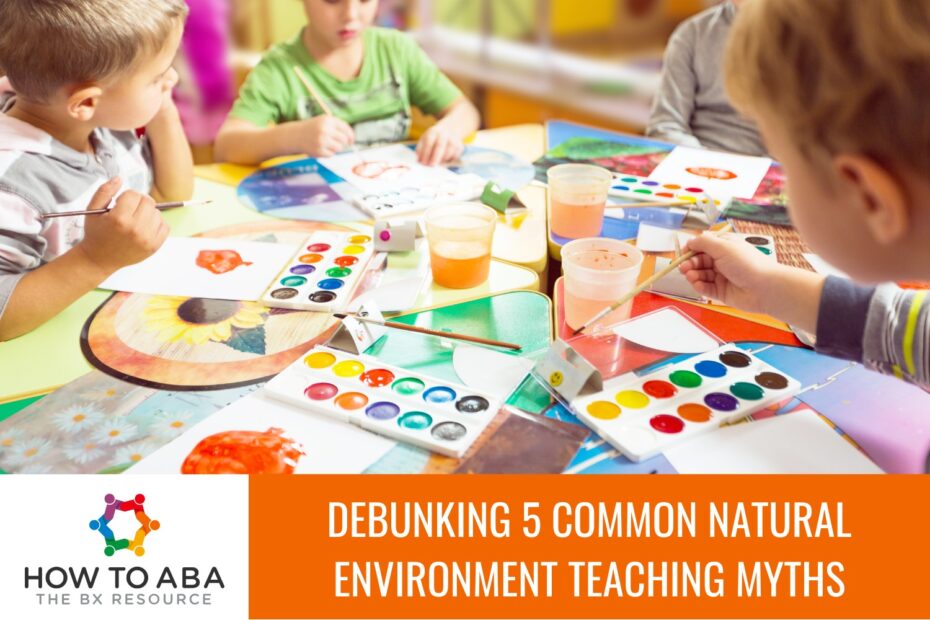When people hear Natural Environment Teaching (NET), the word “natural” can throw them off. It sounds like it should mean free play, loose routines, or letting kids lead with no direction. But here’s the truth: while NET does take place in natural settings, it’s anything but unstructured.
NET is carefully designed, rooted in evidence-based ABA principles, and guided by goals that are individualized to the learner. The beauty of NET is that it blends structure with flexibility – it looks like play on the outside, but inside it’s very intentional.
Let’s break down five of the biggest myths about NET and what’s really true.
Myth 1: NET is Just Playtime With No Real Structure
This is probably the most common misconception about NET. To someone observing, it may appear that the therapist and child are simply playing with toys or chatting at the park. But what’s really happening is targeted skill-building.
The therapist identifies learning opportunities within the child’s interests and everyday routines. That could mean working on requesting skills while playing with blocks, practicing turn-taking during a game of tag, or teaching new vocabulary at the grocery store.
Yes, it looks like play – but the structure is there. Each interaction is guided by clear goals and strategies. The child may be laughing and having fun, but the therapist is collecting data, prompting as needed, and reinforcing successes.
Are you a BCBA who loves your work but struggles with feeling overwhelmed, under pressure, and in need of REAL support?

We get it, and we’ve been there too.
As fellow BCBAs, we know how overwhelming it can be to take care of ourselves and the families we serve.
We created The Bx Resource as a way to unite and support fellow ABA professionals. By sharing our materials, guidance, and resources, we can help save you time and energy so that you can feel confident in the work you love!
Become a Pro Member
Myth 2: Since It’s Natural, There’s No Data or Progress Tracking
Some people worry that because NET doesn’t happen in a structured table-top session, the “science” part of ABA disappears. But data collection doesn’t stop just because the environment changes.
In NET, therapists continue to observe and record the frequency of skills, the level of prompting required, and the learner’s response time. This data is then used to make adjustments – maybe increasing expectations, reducing prompts, or introducing new targets.
The difference is that data isn’t collected in a rigid, drill-style way. Instead, therapists learn to capture it within the flow of activities, using methods that don’t interrupt the natural context. NET is about blending structure into real life, not abandoning it.
Myth 3: NET Doesn’t Support Generalization; It’s Too Context-Specific
Another misconception is that because NET happens in natural contexts, skills won’t generalize beyond that setting. The truth is the opposite: NET is one of the best ways to promote generalization.
Think about it. A child who only practices labeling colors while sitting at a therapy table may struggle to identify colors in the real world. But if that same child learns “red” while playing with a favorite toy car, or while picking out fruit at the store, the skill is tied to everyday life.
NET makes learning functional. Instead of hoping skills transfer outside the therapy room, they’re taught directly in the places where kids will use them. That makes it far more likely those skills will stick and expand into new environments.

Myth 4: NET Lacks Measurable Outcomes, So It’s Less Effective
Because NET looks different from traditional teaching, some assume it’s “looser” or less effective. But measurable outcomes are built right into the process.
Therapists identify specific goals, such as increasing spontaneous requests, improving social interactions, or using new vocabulary. Then they embed opportunities to practice those goals naturally throughout the day. The outcomes are tracked just like in other ABA approaches – frequency, accuracy, level of independence, and so on.
The difference is that the data reflects real-world performance, not just behavior at a therapy table. That makes the outcomes not only measurable but also meaningful.
Myth 5: NET Is Too Casual; Only DTT Counts as Real Therapy
Discrete Trial Training (DTT) is well-known for its structured approach and success in breaking down skills into small, teachable components. But that doesn’t mean NET is less legitimate. They’re simply different approaches, each with unique strengths.
DTT is great for teaching brand-new skills or building strong foundations. NET takes those skills and makes them functional, helping learners use them in everyday settings. Without NET, kids may learn a word at the table but struggle to use it naturally with friends or family.
In fact, many ABA programs combine both methods. DTT introduces and strengthens a skill, while NET ensures that the skill is applied and maintained in the real world. It’s not about one being “better” – it’s about balance.
Are you a BCBA who loves your work but struggles with feeling overwhelmed, under pressure, and in need of REAL support?

We get it, and we’ve been there too.
As fellow BCBAs, we know how overwhelming it can be to take care of ourselves and the families we serve.
We created The Bx Resource as a way to unite and support fellow ABA professionals. By sharing our materials, guidance, and resources, we can help save you time and energy so that you can feel confident in the work you love!
Become a Pro Member
What NET Really Is
Now that we’ve cleared up what NET isn’t, let’s talk about what it actually is:
- Child-led, goal-driven learning: NET taps into a child’s natural interests while keeping clear therapeutic goals in mind. It’s not random – it’s focused and intentional.
- Natural reinforcement: Instead of stickers or tokens, NET uses real-life rewards. If a child asks for a toy, the reward is getting to play with it. If they use a social phrase correctly, the reward may be laughter, attention, or another turn.
- Flexible but data-driven: Therapists adjust in the moment – changing prompts, shifting activities, or using new reinforcers – while still tracking progress systematically.
- Focused on lifelong skills: NET is about teaching what really matters. Skills like communication, social interaction, and independence aren’t just taught in theory—they’re practiced where life actually happens.
NET isn’t about choosing play over structure. It’s about recognizing that learning doesn’t only happen at a desk. By embedding therapy into the natural flow of a child’s day, NET makes skills meaningful, memorable, and functional.
When families and therapists adopt NET, children learn not only to respond to prompts but also to truly engage with the world around them. And that’s the ultimate goal: helping kids build skills that stick, in places that matter most.

